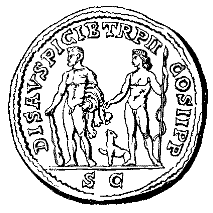How to Identify Ancient Roman Coin?
I still remember the first time of identify ancient Roman coin. It was small, dark, and covered in tiny worn-out letters I couldn’t read. The face on it looked like a grumpy old man wearing a laurel wreath — no date, no country, just mystery.
That single coin opened a door to the entire Roman Empire.
If you’re holding a coin like that right now and wondering “Who is this? What does this say? How old is it?” — don’t worry. I’ve been there. Let’s walk through how you can identify your Roman coin, one clue at a time.
🧭 Step-by-Step: How to Identify Ancient Roman Coin
🔹 1. Start with the Obverse (the Front)
Flip the coin to the side with the portrait. This is usually an emperor — though sometimes it could be a family member or deity.
Look closely:
-
Is he bearded? Probably later Empire (like Hadrian or Marcus Aurelius).
-
Clean-shaven? Could be early (like Augustus or Trajan).
-
Wearing a laurel crown or radiate crown?
Even worn coins tell a story. The style of the face and headgear helps narrow down who it is.
🔹 2. Look at the Reverse (the Back)
This side often carries a message — sometimes political, religious, or symbolic. You might see:
-
A goddess (like Roma or Victory)
-
An altar, eagle, or military standard
-
A building like a temple or aqueduct
Sometimes the reverse image reflects something the emperor wanted to celebrate — a military win, a divine connection, or public works.
🔹 3. Read the Legend (That Ring of Latin Letters)
This is where most beginners get overwhelmed — but here’s the trick: You don’t need to read Latin fluently. You just need to spot the abbreviations.
Some of the most common include:
-
IMP = Imperator (commander)
-
AVG = Augustus (emperor title)
-
TRP = Tribunal Power (tied to Roman law)
-
COS = Consul
-
SC = Senatus Consulto (for bronze coins, Senate-approved)
So a legend like IMP CAES TRAIAN AVG GER DAC PM TRP COS VI PP tells you this is Trajan, and gives clues to his titles and the year the coin was struck.
🔹 4. Feel the Metal — and Weigh It If You Can
-
Silver? Likely a denarius or antoninianus
-
Bronze? Could be a sestertius, as, or dupondius
-
Gold? You’ve got something rare — probably an aureus or solidus
A good digital scale can help identify the denomination by weight.
🔹 5. Check for Mint Marks
Some coins — especially in the later empire — include marks that tell you where they were minted.
Look on the bottom of the reverse, in the “exergue” (that little space below the image). You might see:
-
ROMA = Rome
-
ANT = Antioch
-
LUGD = Lugdunum (modern-day Lyon)
-
SC = On bronze coins, not a mint, but “approved by the Senate”
These details matter. They help you place the coin geographically and sometimes even narrow it down to a 1–2 year period.
🔍 Symbols That Show Up Often (and What They Mean)
| Symbol | What It Represents |
|---|---|
| Eagle | Power, Rome’s military might |
| Victory | The winged goddess of triumph |
| Roma | The spirit or personification of the city |
| SPQR | Senate and People of Rome |
| Altar | Religious significance |
| Mars | God of War |
Roman coins weren’t just money — they were propaganda.
📘 Latin Legend Glossary (Bookmark This!)
These pop up everywhere:
-
IMP – Imperator (military leader)
-
CAES – Caesar (imperial name/title)
-
AVG – Augustus (the emperor)
-
TRP – Tribunal Power
-
COS – Consul
-
PP – Pater Patriae (father of the country)
-
SC – Senatus Consulto (Senate approval for bronze)
📊 Quick Coin Identification Chart
| Feature | Helps You Identify… | What to Look For |
|---|---|---|
| Obverse | The ruler/emperor | Facial style, beard, crown, hair |
| Reverse | Theme or event | Symbols, deities, temples |
| Legend | Titles, reign info | Abbreviations: IMP, AVG, COS, etc. |
| Metal | Coin type (value) | Bronze, silver, gold |
| Mint Mark | Location of mint | ANT, ROMA, LUGD, or “SC” on bronze |
❓ Frequently Asked Questions
How do I read Latin on Roman coins?
Look for familiar abbreviations. You don’t have to translate everything — just spotting IMP, AVG, and the emperor’s name gives you a huge clue.
What do the images mean?
They’re often symbolic. A goddess might represent peace or prosperity. An eagle shows military strength. Even the temple might symbolize a specific achievement.
Can I date a Roman coin from the legend?
Yes — often! Look for COS III or TRP VIII — those titles were awarded yearly, so you can date the coin to a specific year in the emperor’s reign.
📥 Want a Printable Coin ID Guide?
I made a free cheat sheet with the most useful Latin terms, coin types, and imagery examples to help you ID Roman coins faster — perfect to keep beside your collection.
📩 Click here to download the Roman Coin ID Guide (PDF)
📚 Related Reading for Collectors
-
🔎 Roman Coin Values: A Collector’s Guide
🛠️ Recommended Tool for Collectors
Need a magnifier, scale, or coin album?
Check out our curated list of Coin Collecting Tools for beginner to advanced collectors.
